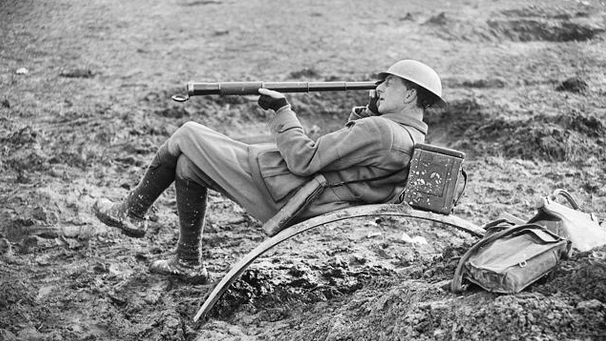
What if the fates conspired to draw the new nation of Australia, mortified by its convict origins and unsure of its status in the world, into the most cataclysmic war the world had ever seen? What if this Great War called forth vast numbers of its young men, eager, bold, and brave, had them travel halfway across the world, and had them thrown into one of the greatest military gambles in history at Gallipoli, only to have it fail at colossal cost?
And what if it then demanded of the survivors and of even more young volunteers that they venture on to France and Belgium, to throw themselves into even more battles of unimaginable carnage, leaving tens of thousands upon thousands dead and maimed, ultimately sharing a great victory, but scaring a generation and searing the soul of a nation?
And what if amongst it all there was a man with the right set of skills and knowledge, the energy, tenacity and courage, officially commissioned to record it all, to spend every waking hour in every battle zone he could access, talking to every soldier he could, analyzing and reporting on every battle, every blunder, and every triumph of our young nation’s army as it plunged into and through the Great War?
It seems that certain people appear in history destined to accomplish one great task, and that family, circumstances, and events conspire together to equip them for their mission. Nobody better exemplifies this phenomenon than Charles Edwin Woodrow Bean, Australia’s official war correspondent in the Great War, the editor of the 12-volume Official History of Australia in the War of 1914-1918 (of which he wrote Volumes I-VI), the driving force behind the establishment of the Australian War Memorial, and the man who formulated and gave shape to the Anzac legend.
Bean’s was a prodigious achievement that easily surpassed the efforts of any other war correspondent or military historian from any nation that fought in the war. He had embarked for Egypt with the first contingent of the 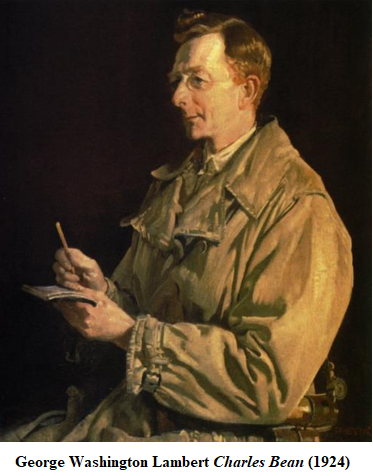 Australian Imperial Force in October 1914, as a civilian but with the uniform and honorary rank of captain, and in April 1915, he sailed from Egypt with the main body of the AIF, going ashore at Anzac Cove on 25 April less than six hours after the first troops. From that moment on he devoted himself to the careful recording and reporting of the AIF’s exploits on Gallipoli and the Western Front, despite being wounded, frequently ill, and constantly under fire.
Australian Imperial Force in October 1914, as a civilian but with the uniform and honorary rank of captain, and in April 1915, he sailed from Egypt with the main body of the AIF, going ashore at Anzac Cove on 25 April less than six hours after the first troops. From that moment on he devoted himself to the careful recording and reporting of the AIF’s exploits on Gallipoli and the Western Front, despite being wounded, frequently ill, and constantly under fire.
Later, he was able to publish his first volume of The Story of Anzac in 1921, before any other official historian. Moreover, he achieved an unsurpassed precision. As Denis Winter points out in Making the Legend: The War Writings of C.E.W. Bean (1992), to match the level of detail achieved by Bean in his six volumes of the History relative to the number of troops involved, the British would have had to produce 84 volumes, but managed only 16. Moreover, Bean’s approach to his task was pioneering in its perspective. As Winter points out, he shunned the usual official approach, based on the Prussian account of the 1870 Franco-Prussian War, which produced a “narrative shorn of critical comment, devoid of controversy and describing accounts from the single viewpoint of the high command”. Bean’s perspective was quite different: “His narrative switched from platoon commanders in battle to corps headquarters in the rear and all points between, with the mind of the high command only one of several” perspectives mobilized to reveal the full story. Moreover, he was prepared to describe failed military actions in detail and to offer strong criticism of military commanders.
Bean was also skeptical of “the conventional assumption that the dispatches of high commanders were the best source of information about what actually happened when men went into battle”, as Ken Inglis observed in his article, “C.E.W. Bean, Australian Historian” (1969). Bean was only too aware of how often such generals thought some movement of their troops reflected their orders, when in fact “it had actually been initiated and carried out by a company commander or one of his men on the spot”. He sought always to penetrate the ‘fog of war’ to reveal “what actual experiences, at the point where men lay out behind hedges or on the fringe of woods, caused those on one side to creep, walk, or run forward, and the others to go back”.
He was also determined to show that “Australian soldiers, sailors, airmen and nurses were a fair cross-section of our people … that the company commander was a young lawyer and his second in command and most trusted mate a young engine driver and so on”. Consequently, Bean filled his pages with the exploits of soldiers; over 8000 were named, with some 6,550 receiving a footnoted biographical sketch. This was a Herculean achievement in itself, which immortalized in the Official History the efforts of the mass of the soldiers who fought for Australia in a manner that had no parallel anywhere else.
During the Great War some 420,000 Australians served in the military with 332,000 serving overseas. Over 61,000 Australians lost their lives and about 156,000 were wounded, gassed or taken prisoner, a casualty rate of almost 65 percent, one of the highest of all nations in the War. It was amidst the cataclysmic battles of the Western Front that Bean realized the need to ensure the Anzac legacy was preserved. He came to the view that “the only memorial which could be worthy of them was the bare and uncoloured story of their part in the war.” Bean knew he himself would be the best resource for this project as he had witnessed the campaigns and kept 300 incredibly detailed notebooks and diaries describing the experiences of the Australians and how they had performed in battle.
Similarly, at Gallipoli, Bean had noticed how the Australian troops eagerly collected battlefield relics and it 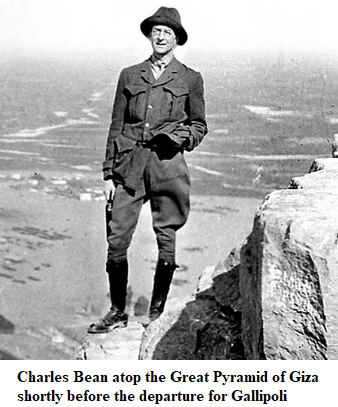 occurred to him that Australia should have a war museum. Consequently, he began planning the establishment of a great national institution that would serve as a permanent museum, a memorial, and an archive for records describing the efforts of the AIF. In May 1917 the Australian War Records Section was established to manage this task, and Australian troops collected and labeled more than 25,000 relics from the battlefield, while official war artists and photographers documented all aspects of the Anzacs at war. This massive effort helped ensure that the Australian War Memorial now possesses one of the best Great War collections in the world.
occurred to him that Australia should have a war museum. Consequently, he began planning the establishment of a great national institution that would serve as a permanent museum, a memorial, and an archive for records describing the efforts of the AIF. In May 1917 the Australian War Records Section was established to manage this task, and Australian troops collected and labeled more than 25,000 relics from the battlefield, while official war artists and photographers documented all aspects of the Anzacs at war. This massive effort helped ensure that the Australian War Memorial now possesses one of the best Great War collections in the world.
In 1919, after Bean had returned to Gallipoli to study the battle from the Turkish perspective, he formally recommended that an official history be prepared and a national war memorial be established which would hold “the sacred memories of the AIF for all time”. The government quickly accepted his proposals and later that year Bean, his staff, and all their records moved into Tuggeranong homestead near Canberra to write the 12 volume series of The Official History of Australia in the War of 1914–1918. Working feverishly, Bean himself wrote the six volumes about the infantry divisions – two on Gallipoli and four on France – while he also edited of the other volumes. The last volume appeared in 1942, 23 years after he started the project, and amidst the darkest moments of World War II. Bean laboured to ensure that the history was accessible to all and sold well. Ultimately, the massive series contained some four million words, 2200 maps, 1500 illustrations and, unlike most other national accounts of the War, Australia’s official history was almost entirely uncensored.
***
The Anzac legend had its origins in the historical outlook Bean brought to his task. As he later wrote, the main theme of The Official History of Australia in the War of 1914–1918 “may be stated as the answer to a question”:
How did this nation, bred in complete peace, largely undisciplined except for a strongly British tradition and the self-discipline necessary for men who grapple with nature … react to what still has to be recognized as the supreme test for fitness to exist?
His answer was precise. As he explained in his tract, In Your Hands, Australians (1918):
… the big thing in the war for Australia was the discovery of the character of Australians. It was character which rushed the hills at Gallipoli and held on there.
Bean had come to the view that “the consciousness of Australian nationhood was born” on the 25th of April 1915. In his later one-volume history of the War, Anzac to Amiens (1952), Bean described what the Anzac spirit involved:
Anzac stood, and still stands, for reckless valor in a good cause, for enterprise, resourcefulness, fidelity, comradeship, and endurance that will never own defeat.
Also at the core of the Anzac spirit was the ideal of mateship. For the soldiers in the Gallipoli campaign and on the Western Front, Bean knew, life would not have been worth living if they had betrayed the ideal of mateship. It was these beliefs that informed his writings, his vision of Australia, and how the nation should honor the sacrifice of the Anzacs.
As it transpired, Bean’s early volumes appeared at a critical time in terms of the writing of Australian history, appearing during the nationalist first phase in the production of military histories of the war that Jay Winter and Antoine Prost identify in The Great War in History (2005). Such works were concerned with “the stuff of national character”, and Bean’s work in particular, “exemplified this approach to military history [as] the chronicle of the birth of [a] nation”. The perspective Bean offered on the Gallipoli campaign transformed “a complete defeat [into a] noble sacrifice”, worthy of a new country, making it “the backdrop to what was essentially a national foundation myth”, and it proved extraordinarily successful in dealing with the social trauma of the post-war years. As Geoffrey Serle observes in From Deserts the Prophets Come (1973), Bean’s work was “unquestionably the outstanding historiographical achievement of the interwar period”, making “a fascinating contribution to defining Australian identity”.
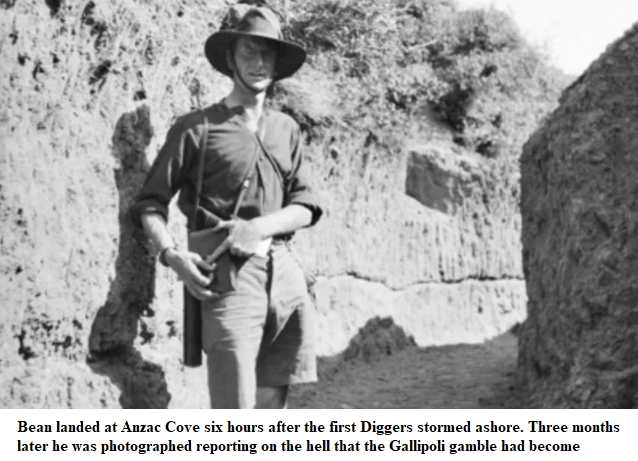
Indeed, Bean had an acute, instinctual sense of Australia’s national identity as a frontier society and of the values of bush stoicism it embodied. He was born in Bathurst on November 18, 1879, and educated there at All Saints’ College, where his father was headmaster, and at Clifton College and Oxford University in Britain, after the family moved there in 1889. Uncertain of his future upon graduation, he returned to Australia and worked variously as a lawyer, teacher, journalist and social historian before he became Australia’s official war correspondent.
His pre-war books included On the Wool Track (1910) and The Dreadnought of the Darling (1911), in which essential elements of the Anzac legend can be found, as Bean explored the epic vastness of Australia while on assignment for The Sydney Morning Herald, where he worked as a journalist once he realized that his true vocation was to write. Finally resolved on this, he had left the law, taught himself shorthand, and become a junior reporter in 1908, struggling to survive on a pittance before his initiative and herculean capacity for work propelled him up the ladder and on to important assignments.
These included an epic 1160-kilometre journey West to Broken Hill to report on the rival proposed railway routes to the booming mining town; another saw him on the roof of Australia, covering the opening of the Kosciusko Hotel in 1909. Another story saw him on a river boat steaming down the Darling River. A further epic journey followed the footsteps of Charles Sturt from the upper reaches of the River Murray to its mouth, where Bean finally came to rest, sitting on a sandhill and meditating on the vast catchment of the Murray-Darling basin, bringing the waters of half a continent to that very spot, where “sitting here I can see them all [mingled together] within 25 yards of my left foot …”
A further assignment took him into the outback to explore the wool industry. Searching for a theme that would capture the reader’s attention, Bean focused on the people of the industry, explaining in On the Wool Track that, while “the wool industry turns out wool and meat … and many other things … the most important things it turns out are men” — men who possessed a unique set of characteristics that Bean would later locate at the core of the Anzac legend. With hindsight he recalled how he also wrote a passage at this time about mateship in outback Australia that finished with the prophetic observation that if ever Britain was in trouble she would discover in Australia “the quality of sticking … to an old mate”.
On the Wool Track became a bestseller, appealing not only to Australians in the cities who had little idea of the outback, but also to Britons and Americans fascinated by the Great South Land that had just become a nation. It was a grim land, as Bean discovered:
The grass had long since disappeared; the face of the country was shifting red and grey sand, blowing about wherever the wind carried it. The fences were covered; dead sheep and fallen trunks had become sandhills. Millions of trees were killed; the birds were dropping dead.
It was also an atavistic land where the distance between domesticity and savagery was small. Left untended, docile stock quickly devolved to their primitive origins, with the descendants of domestic pigs long before released into the bush now looming as “fierce active brutes [with jaws] gnashing till the foam flakes away … for the tameness is easy to rub off. But the wildness is not”. And, of course, the same danger of degeneration existed always for the people of the outback. Unsurprisingly, “some men’s nerves had broken down under the conditions, and they had to flee from the back country in fear for their sanity”.
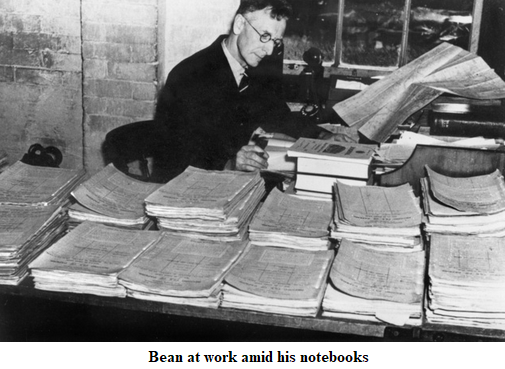
Writing shortly after Joseph Conrad published Heart of Darkness, Bean realized, like Conrad, that civilization was a fine veneer beneath which there lay darkness, even madness. In such a harsh and unforgiving land men and women had to stand firm before adversity, work hard, make sacrifices, cooperate, and help each other as they struggled to survive and build their lives. It was an environment that didn’t encourage hierarchy or servility, but bred instead the stoicism, egalitarianism, and mateship that Bean was to locate at the core of the Anzac spirit.
The book’s obvious connection with the Anzac legend was recognized by H.M. Green in A History of Australian Literature (1961), where he remarked that the book well depicted “the outback that has created some of the most vital of the types that went to make up the Anzacs”:
The outback Australian’s self-confidence, his independence, his readiness to ‘work a point’; his quiet resourcefulness, and also his terrible habit of leaving a thing when it is ‘near enough’; all these attributes are illustrated by anecdotes, often humorous, occasionally tragic, always picturesque … The description of the country itself is only less interesting than that of the people it helps produce.
In these books and during the few years before he set forth with the AIF to far distant Gallipoli, Bean came to realize the place that the land would long hold in the imagination of his nation.
Between 1910 and 1912 Bean was the SMH’s London correspondent and wrote regularly on military matters, ranging from the Balkan wars to the construction of the core of Australia’s first naval fleet, the two cruisers, HMAS Sydney and HMAS Melbourne, and the battlecruiser HMAS Australia. He also published Flagships Three in 1913, in which he explored the history of sea power, from a Viking ship unearthed from beneath the Scandinavian sands, to the Powerful, with her singular contribution in the Boer wars, and the Australia, the future of his country’s role as a naval power in the Pacific. Called back to Sydney to become the Herald’s senior leader writer, from June 1914 he wrote a daily commentary on the European crisis as it intensified and moved remorselessly towards the outbreak of the Great War.
And then, in September 1914, Bean had his career-defining ‘big break’. Australia, along with the other British Empire dominions, was invited to attach an official correspondent to its military forces as they entered the War. Bean had already been lobbying desperately to accompany the AIF on its mission, and eventually, in a fiercely contested ballot, he narrowly defeated Keith Murdoch of the Melbourne Herald for the Australian Journalists’ Association nomination as Australia’s official war correspondent. (Undeterred, Murdoch contrived to be sent to Gallipoli and later covered much of the war alongside Bean, intervening controversially with the British and Australian governments on various strategic issues, including the Gallipoli campaign.)
And so it transpired on October 21, 1914, that Bean was aboard HMAT Orvieto, the flagship of the AIF transport fleet, ready to depart for the Middle East. He was 34; he knew Australia and especially the bush, the people who lived there, and their stoic posture towards the challenges of life; he was a product of the British Empire at its zenith, and he identified strongly with its civilizing mission; he’d made himself familiar with modern military matters and with the officers who’d shortly be leading his country in war. Above all, he knew the desperate hopes Australia had invested in the young volunteers about to depart on their heroic mission, and he possessed a fierce desire to stand witness to his country’s birth in battle.
History had now brought him to this spot, and he gazed down from the high decks at his beloved father standing on the Melbourne docks below. He’d earlier said a sad farewell to his mother – like innumerable other Australian mothers she couldn’t face the trip to the wharf to watch a son disappear over the horizon into a war that was already known for its indiscriminate and mass carnage.
It was a moment of immense loneliness, as Bean recalled, but also grim exhilaration. And so, after a time, he brought his emotions under control, turned and went below to his cabin, preparing to greet the men with whom he’d share the inconceivable experiences of the next four years. In their company he was beginning an odyssey that would define his life, enshrine their exploits in the Anzac Legend, and forever shape Australia’s national identity.
 Sign In
Sign In 0 Items (
0 Items ( Search
Search









Very good Mervyn. You’ve captured Bean beautifully I feel, and in fact you write as if you wouldn’t have made a half bad official correspondent there yourself. I still can’t view the Gallipoli campaign as the horrible, horrible defeat some like to portray it as, ( mainly our friends on the left I think ) or the overall plan itself.
In fact it would have been seen as a stroke of genius if events had transpired just a little differently in the first days of the landings. Everyone knows, or should know, that luck can play a big part in war, and in the initial stages it conspired against us I’m afraid, starting with the biggest stroke of it when our landing boats were moved off course in the dark by the current, and we landed on the wrong beach, with upright hills not the rolling flat country we should have had, and which the whole element of surprise needed for rapid movement inland.
Even so we almost did it and got right over the hills and but for lack of communication back down to the beach we could still have broken through. To knock the Turks out of the war early would have been a master stroke and shortened the war, plus it would have saved a million Armenian lives because the Young Turk Government in Constantinople started the genocide on the Christian Armenians literally days after we landed , if not on the same day.
We should also remember that going by the old way of who wins a war, i.e. who loses the most men, we won, and not only that, we left on our own terms which is usually called a strategic retreat, not a defeat and lost not one man in the evacuation. In fact we may well have been still inflicting casualties on the Turks when our troops were all gone because the men had set up rifles in the trenches aimed at the Turks, with apparatuses cleverly attached involving water dripping at different rates into containers tied to the triggers, to keep up some firing long after we’d departed.
I should also add that I think the Brits had similar experiences and I’m not sure about the French, but all it needed was for one of the landings to break through to throw the Turks into turmoil, and we always were the best chance of achieving that.
Great writing. Thank you.
A fitting tribute to a great man – far greater than any of his critics.
Bean did nothing to help our greatest general, Monash. Luckily Monash was able to convince the PM, Hughes, that he was the man to lead the Australians in the defeat of the Germans. Had PM Hughes listened to Murdoch and Bean the successes in the last six months would not have been achieved. Monash’ other major contribution was the combined arms team approach to warfighting, a concept that was eagerly adopted by Heinz Guderian and used with devastating success in the attack on France and Russia in WWII.
“Anzac stood, and still stands, for reckless valour in a good cause, for enterprise, resourcefulness, fidelity, comradeship, and endurance that will never own defeat,” wrote Bean. What does that sound more like: Hiding behind a mask, going nowhere and doing nothing but what the government gives one permission to, and allowing one’s children to be given a not-thoroughly-tested medical treatment for an illness that bears them almost no threat? or Thinking and researching for oneself, doing one’s best to keep businesses open, continuing to visit friends at all times, losing one’s job rather than support a rotten system, and risking police attack to speak out against dictatorship?
As grateful as I am to the soldiers who have and still do guard our the freedoms God gave us, I have thought many times today of those other modern soldiers–especially those who were driven off Melbourne’s war memorial by a police raid on September 22, 2022. They, too, fought for all of us and for generations yet unborn.
Lest we forget.
Rebekah. You have struck a serious chord with your comment and asked an extremely pertinent question. Are we true successors to the ANZACs? Are we willing to face the foe no matter the personal cost? The answer you give is a resounding “NO”. We have allowed ourselves to be beaten down but worse it seems that many were willing to be beaten down. There are those who continue to wear masks in the forlorn hope it will protect them when it has been proved over and over that they are ineffective. Some people seen to enjoy being slaves, being directed by those “that know better”; by a chief medical officer who doesn’t know what a woman is. You sound like someone who has no such lack of knowledge nor the courage to express it. When the possibility of causing offence prevents open discourse we have come to a bad place, a place unrecognisable by the men of the 39th Battalion on the Kokoda Track for example.
Rebekah and Lawrie ; good comments both, in my eyes.
Gallipoli was a good idea done badly.
Lawrie, as I understand it Bean repented of his anti-Monash sentiment after the war. It may well have been anti-Semitism that formed his prejudice, although he also held a very high opinion of White which may have been the major contributing factor.
As for Monash, he also succeeded masterfully in the repatriation of the army, in institutionalising annual public remembrances, and in establishing Victoria’s electricity infrastructure for the masses.
On ANZAC day the Canberra service commenced with a Didgeridoo sound. An instrument that was not heard in that area until after the city was built and had nothing to do with ANZAC day.
Switch to Perth. An invitee list of 500 people only, no plebes. Started with the extremely offensive and fraudulent “welcome to country” followed by a reading of the names and titles of all the tex payer funded people that were somehow on the list and needed to be named.
This then closed out with the requiem being read by some military guy in a poms accent because that’s what we need to hear on ANZAC day. Absurd.
There’s a song I’ve always liked called “The Price of Freedom,” by an American named Ron Hamilton. It has even more meaning, now, than it did when it was written in the ’80s. In the chorus, our family has made one change to make it an Australian song.
Our fathers made the sacrifice,
Tho’ the fight was long.
They shed their blood, they paid the price–
Singing freedom’s song.
Chorus
Remember, remember the price that was paid.
Remember the sacrifice Australia’s sons have made.
Be faithful to that vision,
Though others turn away.
Never forget the price of freedom.
Come guardians of this sacred trust,
Keep our nation free.
Our duty’s clear, our cause is just;
Fight for liberty.
Sorry, I forgot about the spacing issue.
–
Our fathers made the sacrifice,
Tho’ the fight was long.
They shed their blood, they paid the price–
Singing freedom’s song.
–
Chorus
Remember, remember the price that was paid.
Remember the sacrifice Australia’s sons have made.
Be faithful to that vision,
Though others turn away.
Never forget the price of freedom.
–
Come guardians of this sacred trust,
Keep our nation free.
Our duty’s clear, our cause is just;
Fight for liberty.
So 65,000 dead and 156,000 wounded etc, out of 332,000, is 66.5%.
If we allow for say, 20% non combatants who would likely have experienced relatively low casualty rates, then the figure goes up to 83% for those who saw combat, or pretty much everybody. Although we know that many were wounded multiple times, and it isn’t clear whether these figures count those.
I’ll bet those statistics weren’t made available when the vote for conscription came up, if contemporary politics is anything to go by.